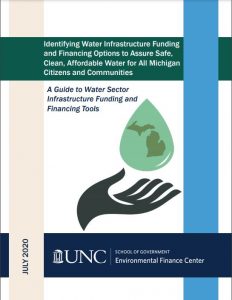Many communities across the United States are dealing with aging water infrastructure and have growing extensive capital needs. Michigan is no exception to this problem, with the state currently facing an $800 million annual gap in its water and wastewater infrastructure needs. An estimated investment of between $14.6 billion and $20.3 billion is needed in Michigan’s drinking water infrastructure between 2011 and 2030, in addition to an estimated $2.14 billion investment for the state’s wastewater and stormwater infrastructure. With such significant financial investments needed in the water sector, now more than ever it is critical to identify the financial mechanisms that can be used to most equitably, effectively, and efficiently provide residents with reliable, reasonably priced water services.
This report explores seven finance options as tools to pay for the infrastructure needed to provide clean, reliable drinking water, wastewater, and stormwater services for all Michigan communities:
1.Affordability and an Affordability Rate Structure
2.Environmental Impact Bonds
3.Revenue Bonds
4.Statewide Bonds
5.State and Federal Grants and Loans
6.User Fees, Taxes, and Surcharges
7.Privatization
Download The Resource






